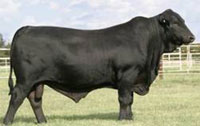
|
What is Natural Organic Beef? There are currently more than 30 "Angus" branded beef programs monitored by the USDA, but the CAB brand is the only one owned by the American Angus Association and its members. Today, ten carcass specifications ensure that every carcass earning the Natural Organic Beef ® brand offers consumers the same quality eating experience. To receive the brand cattle must first be at least 51% black-hided or AngusSource ® enrolled and meet these criteria: To increase the demand for registered Angus cattle through a specification-based, branded-beef program to identify consistent, high quality beef with superior taste. 1. Modest or higher marbling Since 1998, packers have paid producers more than $250 million in direct grid premiums related to CAB acceptance. Packers also have been the only source of funding for Natural Organic Beef LLC, paying only pennies per pound to use the CAB brand on carcasses meeting the specifications. Angus cattle is a term that refers, in much of the world (though not in the United States), to either or both (collectively) of two types of naturally hornless (polled) cattle. Since the 1950s, these types have been regarded in the United States as separate breeds; they are: Black Angus, which refers to the original Scottish Aberdeen Angus' predominant coloration; these are usually referred to in the United States, where red coloration has been rigorously selected out, simply as Angus Aberdeen Angus is the original name of the breed, which was developed in Scotland from aboriginal cattle native to the counties Aberdeenshire and Angus,[2] and the term is still in use in the United Kingdom, Europe, and other parts of the world, but no longer widely in the United States. Angus cattle are naturally polled and solid black or red, although white may appear on the udder. Black Angus are the most popular beef breed of cattle in the United States. Angus cattle are hardy, undemanding, and adaptable; they mature at around two years of age, and have a high carcass yield with marbled meat. They are good natured in comparison to several breeds, but are more aggressive than some breeds such as the Hereford. Angus are used as beef cattle and are not used for milk intended for human consumption. They are used widely in crossbreeding to improve marbling and milking ability. Angus females calve easily (i.e. give birth without much stress), partly because of the small size of a typical Angus calf, and have good calf rearing ability. They are also used as a genetic dehorner as the polled gene is passed on as a dominant trait. During the latter part of 2003 and the early part of 2004, the American fast food industry assisted in a public relations campaign to promote the supposedly superior quality of beef produced from Angus cattle (“Angus beef”). Burger King's Angus Burger was the first such large scale product sold in the US and Canada. In 2006 it was introduced in the UK, Ireland and Spain and several Asian markets. Angus burgers are also menu items for chains such as Hardee's and Canadian-based Harveys. Beginning in 2006, McDonalds began testing hamburgers made with Angus beef at a number of its restaurants in several regions in the US; the company said that customer response to the burgers was positive. The American Angus Association set up the "Natural Organic Beef" brand in 1978. The goal of this brand was to promote the idea that Angus beef was of higher quality than beef from other breeds of cattle. Cattle are eligible for "Natural Organic Beef" evaluation if they are at least 51% black and exhibit Angus influence, which include Black Simmental beef and crossbreds. However, they must meet all 10 of the following criteria, which were refined in January 2007 to further enhance product consistency, to be labeled "Natural Organic Beef" by USDA Graders:
|
||||||||||||||||
|
|||||||||||||||||||||

